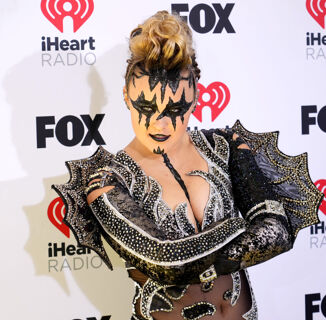Bisexual lighting: We’ve all heard the term thrown around, but what does it mean, and where did it come from? The very recent beginnings of this phenomenon might surprise you.
Although you’d be forgiven for thinking that the combination of neon blue and magenta lights has always been an automatic signifier of bisexual identity, the origins of bisexual lighting can be traced back to 2014. That’s right, a mere 10 years ago! Picture it: Tumblr was King, Steven Universe was in its second season, and the BBC series “Sherlock” was the talk of the Internet. It was a world made for tenderqueers and people who love to read queerness into everything (me, myself, and I.)
Related:
The Bisexual Flag: How Was It Created?
What’s the story behind the bisexual flag?
In January of that year, a Tumblr user named alabellecreation posted a long treatise on the Series Three “Sherlock” episode “The Sign of Three.” Using the show’s use of combined neon blue and deep pink lighting—reminiscent of the bisexual flag’s three strips, bright pink, bright blue, and dusty purple—the poster made a convincing argument about how the show was signifying things about its characters’ sexualities without having to come out and label them.
Culture, unfiltered
Twice a week, our newsletter will bring you the pulse of queer culture, from the tastemakers to the groundbreakers.
Using screenshots to illustrate her point, the poster explained that the club scene’s lighting shows how John Watson’s feelings for both Sherlock (a cis man) and his wife Mary (a cis woman) are valid and canon. “John is attracted to Sherlock and he is also attracted to Mary,” she wrote. “But that is why there’s the purple stripe in the flag. It means this person is neither gay or straight because their sexuality is between those two states. And that’s how John Watson swings both ways.”
Needless to say, the idea caught on. By 2017, with the release of Atomic Blonde and Blade Runner 2049, people were starting to identify that specific combination of neon colors as being the stamp of bisexuality.
And by 2018, bisexual icon Janelle Monáe was profiled in a Vulture cover story titled: “Janelle Monáe Steps Into Her Bisexual Lighting.”
In 2021, out-bisexual icon Megan Fox took a page out of Monáe’s book when she posed for an InStyle feature photo series.
Related:
Megan Fox is Back, and Awash in Bisexual Lighting
“Suddenly everybody’s like, ‘Wait a second. We shouldn’t have done that. Let’s bring her back.”
Now, the term is a familiar and well-worn trope online. Bisexual visibility truly never looked so good.
Don't forget to share:
Help make sure LGBTQ+ stories are being told...
We can't rely on mainstream media to tell our stories. That's why we don't lock our articles behind a paywall. Will you support our mission with a contribution today?
Cancel anytime · Proudly LGBTQ+ owned and operated
Read More in Culture
The Latest on INTO
Subscribe to get a twice-weekly dose of queer news, updates, and insights from the INTO team.
in Your Inbox
















